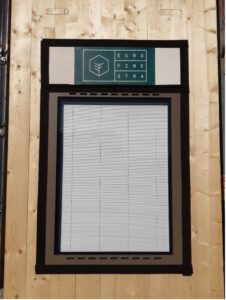The first real-scale Active Window System prototypes have been recently manufactured by Cultural-E partner Eurofinestra and installed in the outdoor laboratories of Eurac Research to perform a dedicated test campaign.
The Active Window system (AWS) aims at converting the traditional window system to an active element that enhances energy efficiency, indoor air quality and user comfort, based on the following four pillars:
– Modular wood frame system;
– Integration of movable adaptive shading system;
– Integration of decentralized ventilation devices;
– Interaction between the shading semi-ventilated cavity and decentralized ventilation device.
Prior to the prototypes and tests, different possible AWS configurations were identified and analysed in terms of feasibility and performance, as explained in Deliverable 3.3 – Active Window configurator tool. A comprehensive simulation activity was performed at system and building level to optimise the design, estimate the performance, and identify the limitations of each configuration. Based on these results, prototypes of the most promising solutions were selected for the experimental campaign, and therefore prototypes manufactured.
Eurofinestra has manufactured two mock-ups, one conceived for cold climates with vacuum-insulated glazing (VIG) and a second one conceived for mild climates with double-glazing. Both mock-ups have, in turn, three different configurations depending on the ventilation mode mounted and tested at each moment, i.e. natural ventilation, passive ventilation through trickle vents, or active ventilation through a mechanical ventilation device. Both mock-ups with their three ventilation modes will be tested one after the other in the “Flexi” lab facility of Eurac laboratories. The presence of a small climatic chamber behind the façade of this facility allows testing the AWS prototypes under external real conditions and internally-controlled conditions.
The first mock-up to be tested, namely the one with the VIG, has been recently installed in the “Flexi” lab facility. The experimental campaign will assess:
– the thermal performance;
– the risk of condensation under most critical conditions (cool and clear sky nights);
– the air movement and flowrates in the shading ventilated cavity.
In order to do that, a comprehensive instrument setup is currently being installed, including several surface and air temperatures, heat fluxes, air velocity and relative humidity measurements among others. In the coming days, once all the monitoring system is installed and running, the testing campaign will start with the aim of understanding better the actual performance of the system and validating the feasibility of this innovative window system.








